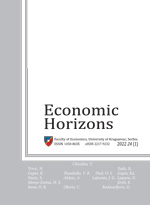
THE JOURNAL IS PUBLISHED
THREE TIMES A YEAR
in April, August and December
Fatih Burak Gümüş1 and Feyyaz Zeren2
1 Faculty of Management, Sakarya University, Sakarya, Turkey
2 Faculty of Economics and Administrative Sciences, Namık Kemal University, Tekirdağ, Turkey
The efficient market hypothesis is one of most important theories in finance and one of the most important research areas for both developed and developing stock markets. In this study, the random-walk hypothesis is tested for the main stock markets of the G-20 countries. The linearity of the series is determined in the first stage. In this context, 16 of 17 markets have a linear structure; therefore, the Fourier ADF unit root test that uses trigonometric functions in order to capture deviations greater than the average of the dependent variable and takes into account multiple structural breaks, is applied to these series. Furthermore, the Fourier KSS unit root test that has the same functions as the Fourier ADF unit root test is used for the Japanese stock market, being the only one market with a non-linear structure. As the result of these analyses, while the markets of the nine countries are observed as effective in the weak form, this hypothesis is not valid for the remaining eight countries. While the prediction of the future price of all of these nine markets will be impossible through a technical analysis, investors in the remaining eight markets can provide returns by carrying out the same analysis.
Keywords:
JEL Classification:
Since March 2015, the Journal is indexed in DOAJ
Since November 2013, the Journal is indexed in ProQuest – ABI/INFORM
Since October 2013, the Journal is indexed in Cabell’s Directories
Since September 2013, the Journal is indexed in Index Copernicus Journals Master List 2012
Since March 2013, the Journal has been evaluated and accepted for listing in EconLit (American Economic Association Publications)
Since January 2013, the Journal has been included into EBSCO’s databases
Since November 2012, the Journal has been included into Ulrich’s Periodicals Directory
Since March 2015, the Journal is indexed in DOAJ
Since November 2013, the Journal is indexed in ProQuest – ABI/INFORM
Since October 2013, the Journal is indexed in Cabell’s Directories
Since September 2013, the Journal is indexed in Index Copernicus Journals Master List 2012
Since March 2013, the Journal has been evaluated and accepted for listing in EconLit (American Economic Association Publications)
Since January 2013, the Journal has been included into EBSCO’s databases
Since November 2012, the Journal has been included into Ulrich’s Periodicals Directory